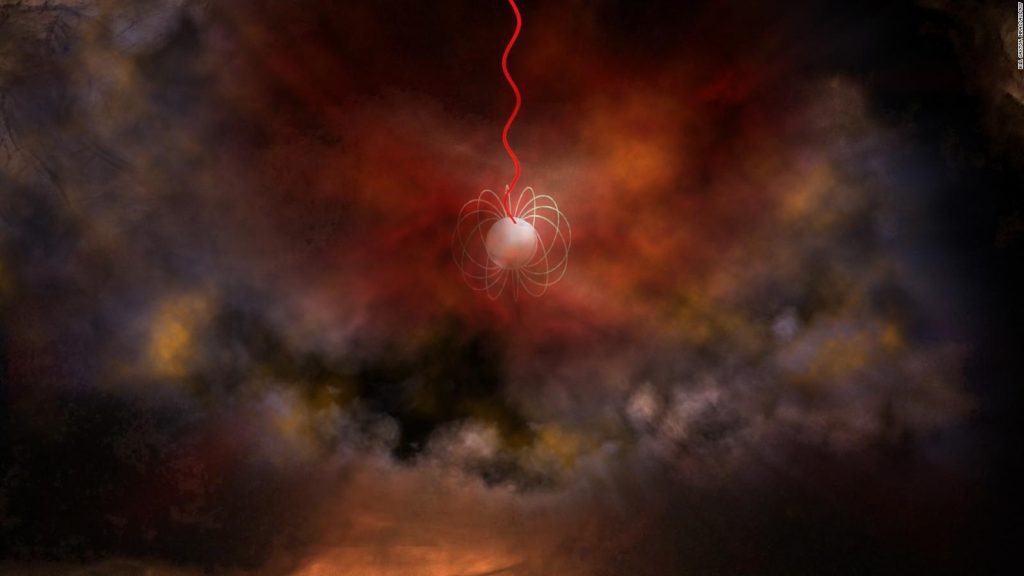(CNN) – Astronomers have detected a mysterious, fast and frequent radio burst emanating from a dwarf galaxy 3 billion light-years away.
The cosmic object is an outlier when compared to the discoveries of other radio bursts in recent years, according to new research.
The fast radio blasts or FRB, are long bursts of radio waves in space. The individual radio bursts are emitted once and are not repeated. But fast-repetition radio bursts are known to emit short and powerful radio waves many times.
Astronomers have been able to trace some of the radio bursts back to their home galaxies, but they haven’t yet determined the true cause of these bursts. Learning more about the origin of these bright and intense radio emissions can help scientists understand their causes.
This image, taken by Karl G. Jansky Very Large Array, shows the object FRB 190520 when it is active (in red).
Astronomers discovered the object, named FRB 190520, when it released a burst of radio waves on May 20, 2019. Researchers used the 500-meter FAST radio telescope in China and detected the explosion in telescope data. In November 2019. Astronomers made follow-up observations and noticed something unusual: the object was emitting repetitive, repetitive bursts of radio waves.
In 2020, the team used the Karl G astronomical observatory. Visible-light observations of Subaru showed that the explosion came from the fringes of a distant dwarf galaxy.
a study A breakdown of the results was published Wednesday in the academic journal Nature.
two of a kind
VLA observations also revealed that the celestial body was constantly emitting weaker radio waves between repeated bursts. This is very similar to the well-known fast-repeating radio burst: FRB 121102, discovered in 2016.
The initial discovery and subsequent tracking of FRB 121102 to its point of origin in a small dwarf galaxy more than 3 billion light-years away was a breakthrough in astronomy. This was the first time that astronomers were able to know the distance and environment of these mysterious objects.
“Now we have to explain this double puzzle and why FRBs and persistent radio sources are sometimes found together,” said study co-author Casey Law, a radio astronomer at Caltech. “Is it common when FRBs are small? Or perhaps the object that causes the eruptions is a massive black hole devouring a nearby star in a chaotic manner? Minimize.”
Currently, less than 5% of the hundreds of identified FRBs are known to be repeaters, and only a few are regularly active.
FRB 190520 is the only continuously active radio burst, meaning it hasn’t been “turned off” since its discovery, said study author Di Li, chief scientist with the Radio Division of the National Astronomical Observatories in China and from the Rapid Operations Center. Meanwhile, Lee said that FRB 121102, “the oldest known repeater known, could go dark for months.”
new questions
The recent discoveries raise more questions, and astronomers are now wondering if there are two types of fast radio bursts.
Study co-author Kshitij Aggarwal, who participated in the study as a doctoral student at the University of Virginia, said: “Are those that repeat different from those that don’t? And continuous radio emission, is it common?” statement.
It is possible that there are different mechanisms that cause radio bursts, or that what causes them behave differently during the different stages of their development.
Previously, scientists theorized that the fast radio bursts were caused by the dense remnants left behind after a supernova, called neutron stars, or neutron stars with incredibly strong magnetic fields called ferromagnets.

This is an artist’s concept of a neutron star with an extremely strong magnetic field, called a magnetar, that emits radio waves (highlighted in red).
Lu said FRB 190520 is considered a “newborn” organism because it was found in a dense environment. This environment may have been caused by material released by a supernova, resulting in the formation of a neutron star. Since this material disperses over time, bursts of FRB 190520 may decrease with age.
In the future, Li wants to detect more fast radio bursts.
“It is likely that a coherent picture of the origin and evolution of FRBs will emerge within a few years,” Lee says.
Lau is excited about the implications of a new class of radio wave sources.
“For decades, astronomers have believed that there are two basic types of radio sources that we can see in other galaxies: the growth of supermassive black holes and the activity of star formation,” Lu said. “Now we say it can no longer be classified as one or the other! There is a new possibility and we need to take it into account when studying groups of radio sources in the universe.”

“Proud web fanatic. Subtly charming twitter geek. Reader. Internet trailblazer. Music buff.”


:quality(85)/cloudfront-us-east-1.images.arcpublishing.com/infobae/76Q3V4IS6W7CAP5TT6MVJGCHMQ.jpg)


:format(jpeg):focal(2425x455:2435x445)/cloudfront-us-east-1.images.arcpublishing.com/gfrmedia/VHMDSLP56BEZDI2PZFVOPDHJGA.JPG)

More Stories
Ray-Ban Meta: How much do Mark Zuckerberg's famous smart glasses cost?
ESA captures mysterious spider shapes on Mars
How can you record your video calls on WhatsApp? This is how it's done on Android – Teach Me About Science